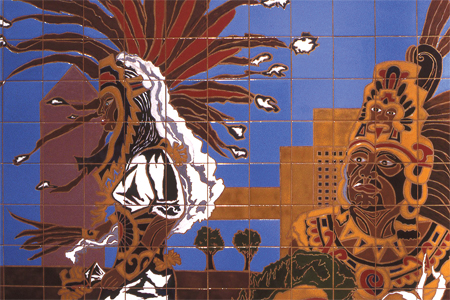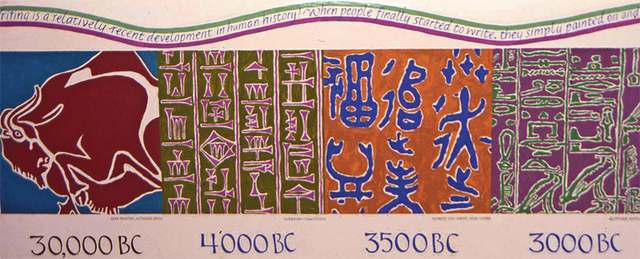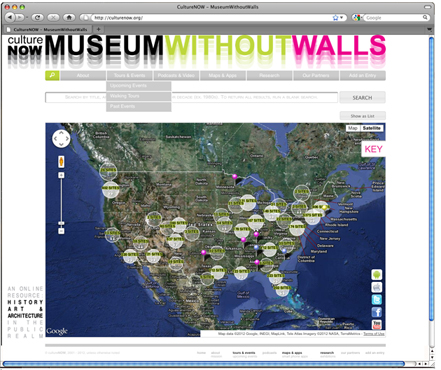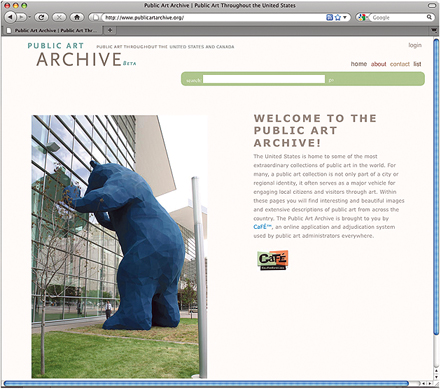You’re waiting for your hair appointment at a Downtown salon, and as usual, you’re staring at your iPhone. You open the Museum Without Walls application you just downloaded and hit the “search using current location” button. A list of nearby works of public art pops up, and your heart flutters.Two are located right down the street at the Barelas Community Center, one of them a 4-by-10-foot tapestry of colcha embroidery, “Historia de Barelas,” depicting the life and culture of the historic Barelas neighborhood, and the other an oil painting called “Coronado’s First Visit to New Mexico.” The description of the painting by Maurice Green also informs you the conquistadors originally referred to New Mexico as Tiguex. And though you don’t have time to jaunt down to the Alvarado Transportation Center to check out the steel-and-tile sculpture “A Stop on the Rio Grande,” your artistic heart continues to palpitate: There’s a video podcast that shows you how it was made. Waiting to get your bangs cut has never been so fun—and just when you thought your smartphone was making you dumber.At least that’s the idea behind Museum Without Walls. Through the efforts of the Public Art Urban Enhancement Program, which is responsible for overseeing the city’s public art collection, 678 works will soon be viewable through this interactive mechanism. Sculptures, paintings, murals and multimedia installations funded through Albuquerque’s 1% for Art program are on the app, which uses a Google map and GPS to locate nearby works of art that your tax dollars helped pay for."We have artwork that’s positioned near strip malls, and if you happen to be going there and you’re aware of your environment, it’s there,” says Albuquerque Public Art Program Manager Sherri Brueggemann. “I’ve heard over and over and over, especially from newcomers who move into Albuquerque, ‘My God, there’s art everywhere. Everywhere I go in this city, exploring a new place in the city, there’s public art there.’ And I hear that from locals, too.”Albuquerque’s is one of more than 60 public art collections being uploaded to nonprofit cultureNOW’s database, which started in the New York City area in 2001 as an effort to map any piece of artwork or fascinating architecture that was either publicly viewable or paid for by public funds. And so far, Albuquerque is second only to New York City for the number of listings uploaded to the database of more than 9,000 sites and 15,000 images. With a total of 593 art projects already uploaded, 85 remain to be included to make Albuquerque’s entire existing catalog available to the public.This is big news for a city that has dedicated 34 years to spending more than $13 million of capital improvement bond monies to erect and acquire artwork for the public good, yet whose catalog of almost 700 projects has remained tucked away in a database in City Hall. The Public Art Program, part of the Cultural Services Department, has offered art maps, walking and cycling tour guides, as well as a Flickr page of public art. But the new mobile app puts the power of curating individualized, free art tours back in the hands of the people. It also allows users to upload publicly viewable works not included in the city’s catalog.When the City Council approved the Art in Municipal Places Ordinance in 1978, Albuquerque became one of the first cities in the country to jump on the Percent for Art idea that had been steadily taking root across the U.S. since Philadelphia pioneered the movement in 1959. Baltimore and San Francisco continued the trend in the ’60s, and New York City, culture capital of the planet, finally got on board in 1982. Now, dozens of U.S. municipalities have some sort of program on the books requiring a certain percentage of voter-approved bonds be added to the total cost of improvement projects solely for the creation of new, publicly accessible artwork.Over the past four years, the Public Art Program has spent an estimated $600,000 annually on new projects. Brueggemann says she expects the same amount will have been spent at the end of this fiscal year to further the completion of 27 in-progress works. Decades of diligent spending have resulted in an extensive public art collection that puts the Duke City on par with larger art hubs like Chicago. And while the Big Apple has spent twice as much on public art through its Percent for Art program, it boasts less than half as many works as Albuquerque.In addition to Museum Without Walls, the city is also making its collection accessible through the Public Art Archive, a searchable U.S. database. With 538 entries already uploaded to the site, Albuquerque is far ahead of any other city attempting the same thing. Meanwhile, it’s working on its own interactive map that will be available on cabq.gov.The full cultureNOW app, which won the 2012 Institute Honors for Collaborative Achievement award from the American Institute of Architects, is still a bit glitchy. When I gave it a test drive, its distance feature wasn’t working, and it indicated that all 593 sites were located zero feet from my location. But it should be noted that it did arrange the list in order of nearest to farthest. Because Google Maps tends to be wrong on occasion, some addresses for the sites were pinpointed in incorrect places. But it’s available for both iPhones and Androids and is well worth the $1.99—a lot less than you’d spend on a museum ticket.













